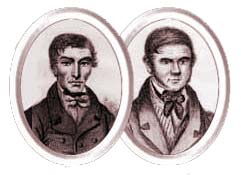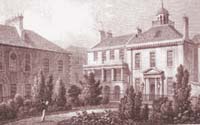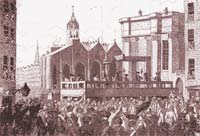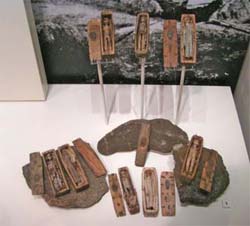WordPress database error: [Got error 28 from storage engine]
SELECT t.*, tt.*, tr.object_id FROM wp_terms AS t INNER JOIN wp_term_taxonomy AS tt ON tt.term_id = t.term_id INNER JOIN wp_term_relationships AS tr ON tr.term_taxonomy_id = tt.term_taxonomy_id WHERE tt.taxonomy IN ('category', 'post_tag', 'post_format') AND tr.object_id IN (5655) ORDER BY t.name ASC
Burke & Hare
The year is 1836 and five young boys are roaming Arthurs Seat in Holyrood park, Edinburgh – hunting for rabbits, what they find defies belief and brings back to the public’s attention one of the most gruesome periods of our capital’s history.
Buried in a small cave they find 17 miniature coffins – each coffin is only 4 inches long and each contains a small carved wooden doll – made with some expertise. Many theories exists as to what these dolls represented but the one that captured the imagination was their co-incidental link to the 17 victims of William Burke & William Hare; The BODY SNATCHERS.
The story of Burke & Hare is fascinating in itself for many reasons, though motivated by greed on the part of the perpetrators, the purpose of the murders and the resulting bodies created a scandal that both shocked the polite society of Edinburgh but at the same time contributed to the city’s standing as a place of intellectual advancement in the development of modern medicine.
We go back to the early 1800s – great advances take place in science and medicine is no exception – however research into anatomy is made difficult as the supply of fresh cadavers on which to experiment are hard to come by. Generally only those executed for murder were given up for dissection and with such a voracious demand from the university there just were not enough murderers to go round, ironically an opportunity arose then for two of the best.
Enter William Burke & William Hare, two Irish immigrants from Ulster who had come to Scotland to work on the Union Canal. The pair probably met when Burke moved to a lodging house in Edinburgh’s West Port area run by Hare and his partner; Margaret Laird. Burke & Hare could never have been considered of high morals and indeed the area around the West Port was rife with criminals, prostitutes and life’s detritus in all shapes & sizes. However they did not suddenly wake up one morning and decide to become Edinburgh’s most notorious serial killers – their path to hell was a little less obvious…
The downfall of Burke & Hare began with a simple problem – what to do with a dead tenant who owed you money? In 1827 an elderly lodger of Hare’s called Donald had died of natural causes in the night – he had no known family and owed Hare £4.49 in rent. Burke listened to Hare curse his bad luck – then a solution came to them. Poor Donald may have been considered worthless in life but maybe not so in death – the anatomists! And so their new career began; on the day of Donald’s funeral they filled his coffin with bark and in the dead of night – wheeled the body to Surgeon’s Square where Professor Knox paid them seven pounds and ten shillings and asked few questions regarding how they had come about the corpse. suddenly from four pounds down they were three pounds ten shillings up, not a bad night’s work!
The scheme had one drawback though – if they had to sit and wait for the next tenant to pop his clogs they could be in for a wait – even in such a god forsaken place as the West Port! As they eagerly eyed their tenants the next victim presented himself; Joseph Miller was already sick, why not help him on his way a little? no harm in that surely? So one night they plied him with whisky and suffocated the poor man. Since they had now exhausted the supply of sick tenants in the boarding house it was time to look elsewhere. In February 1828 Abigail Simpson, an elderly lady was lured into the lodging house and dispatched in the same style, a smothering technique designed not to harm the corpse which grimly became known as ‘Burking’.
Poor Abigail was hardly cold by the time she reached Knox’s back door, This was reflected in Burke & Hare’s payment for this cadaver when the Anatomist paid them fifteen pounds as she was so ‘fresh’.
Over the next year they grizzly trade was carried out from their seedy boarding house
The victims of Burke & Hare were mostly those on the lower rungs of life’s social ladder, those who would not be missed but even in a city the size of Edinburgh not everyone at this level was a complete unknown; The pair had their first close escape when Burke brought back two prostitutes, Mary Patterson and Janet Brown. Brown left after an argument but Patterson was not so lucky. As her body was uncovered on the dissecting table the next morning a collective gasp was heard among the students. Many students had known Mary…intimately!
Several more victims followed in her footsteps; local characters such as Effie a local beggar along with more of Edinburgh’s elderly, poor infirm and immoral including a mother and daughter, Mary Haldane and her daughter Peggy who had been dispatched after arriving at the boarding house looking for her mother. But Mary was to give them yet another scare and arise more suspicion when she was also recognised on the slab.
Still the pair became even more daring – their next victim, young ‘Daft Jamie’ was a well known local character, and his mother reported his disappearance. His unveiling on the dissecting table was shouts of recognition from students, Knox denied that this was the same boy and realising that the blood was on his hands too in more ways than one set about dissecting the poor boy’s face first to ensure no-one would recognise him.
The killing spree of Burke & Hare came to an end on Halloween night in 1828.
Earlier Burke & Hare had argued, Burke had accused Hare and his partner of selling bodies behind his back and Burke and his mistress, Helen MacDougall had set up their own lodging house. On Halloween, Burke befriended a fellow Irish woman Mary Docherty in a local shop, claiming that they were related since his mother was also a Docherty he invited her back to his own lodging house. But Burke had a problem; James & Ann Grey were already tenants in their tiny establishment and Burke knew that murder can be noisy work! Burke paid for the Grays to spend the night at Hares equally infamous home.
The deed was done but next morning Ann Gray returned to collect some items and became suspicious of Burke’s behaviour. That evening the investigated the house and found Mary’s body hidden under a bed in a spare room. The confronted Helen MacDougall who lost her nerve and offered a ten pound bribe to the Grays. The refused and fled to report the murder to the police but by that time Burke had already been tipped off and by the time the police arrived Mary’s corpse was already in the possession of Doctor Knox. An anonymous tip-off led police to Surgeon’s Square where James Grey identified the body. It would have appeared that Burke & Hare’s fate was sealed.
And yet after months of questioning the courts could not make a strong case against Burke, Hare or their womenfolk. Finally Sir William Rae the Lord Advocate made an offer to Hare, turn King’s evidence against Burke and receive immunity from prosecution. The old saying of ‘no honour among thieves’ was ever more true and Hare willingly confessed all to the police implicating Burke and Helen in all the grizzly murders.
Burke’s trial began on Christmas Eve 1828, It was a short trial and he was soon convicted and sentenced to death. Helen’s case was not proven and she was released and fled the country to avoid lynching.
On the 28th of January 1829 a huge crowd gathered at Edinburgh’s Lawnmarket to witness Burke’s ‘last drop’. His body was put on public display and was so popular that almost 60 people a minute files past his remains. Then as a supreme irony Burke’s body took the same path as so many of his victims to the very same dissecting table, students took pieces of his skin and used it to bind a small book which can be still found along with Burke’s skeleton and death mask in the Surgeon’s Hall Edinburgh
Hare was released the following month but there was a public outcry and he fled Scotland. A rumour has it that his identity was discovered and a mob threw him into a pit of lime and blinded him and that he ended his days as a blind beggar in Carlisle. As for Knox the affair had damaged his reputation and although acquitted of any wrongdoing he found himself out of favour in Edinburgh and took up a position at a cancer hospital in London where he died in 1862.
So what of the 17 dolls found years later just a short distance from the scene of their victims dissection. Some discount the connection to Burke & Hare and claim they were connected to some form of witchcraft practice. but the number, 17 is intriguing. some suggest that the tiny coffins were buried as some form of atonement for the sins of the evil pair maybe by one of their partners or maybe even by Hare himself as a way of maybe giving a final rest to the troubled souls he had robbed of life! Fortunately you can make your own mind up – if you come to Edinburgh go to the Royal Museum of Scotland on Chamber’s Street. On the fourth floor you can see the dolls on display.
Related Blogs to Burke and Hare

What Did Happen to William Hare?
Read More









